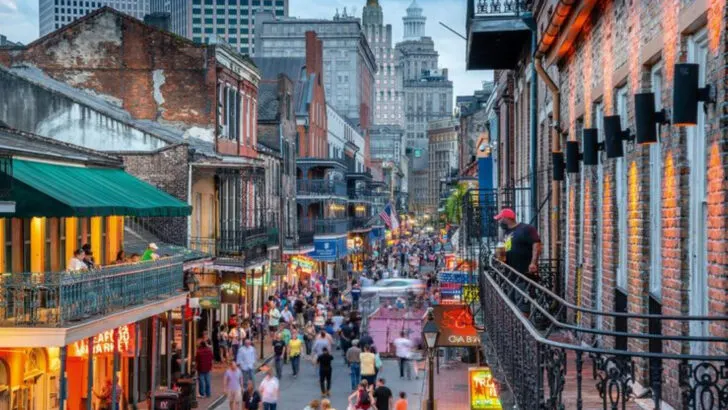Some cities peak—then stall out. What was once magnetic starts to feel a little tired. That quirky café? A chain now. The iconic view? Half-covered by a condo project. Crowds balloon. Prices spike. The soul gets smoothed over and sold back as merch. You visit, hoping for magic— and leave with a parking ticket, a bland latte, and the sneaking suspicion you’ve been duped. We’re not saying these cities are done. But the sparkle? It’s dimmed. Maybe it’s over-tourism. Maybe it’s the influencers. Maybe it’s just time to give someone else the spotlight. Here are 15 once-beloved cities that feel a little less loveable lately.
Austin, Texas
Austin, Texas once thrived with lush native meadows and iconic live oaks that provided solace from the summer heat. However, rapid urban development has taken a toll on these natural elements. The increasing pavement makes it difficult for both plants and people to endure the scorching temperatures.
Older neighborhoods still host small patches of native grasslands, but these are disappearing quickly. The city’s vibrant natural charm is fading as meadows shrink and shade trees struggle to survive in a concrete-dominated environment.
Portland, Oregon
Portland, Oregon, known for its lush gardens and green neighborhoods, is witnessing a transformation. As high-density housing expands, traditional front yards with their beautiful gardens are often replaced by gravel or parking pads. Many homeowners are opting for downsized plantings or entirely removing trees.
While rhododendrons and ferns still line some streets, they are becoming less common. The greenery that once defined the city’s charm is diminishing, giving way to minimalistic landscapes that lack the vibrancy of past flora.
Denver, Colorado
Denver’s charm has always included its lush lawns and native plantings, but water restrictions have altered this landscape drastically. Traditional lawns are slowly disappearing, replaced by drought-tolerant plants. However, these replacements are not always carefully planned, leading to dry, bare lots instead of vibrant xeriscapes.
The potential for a beautiful, water-efficient environment exists, yet the execution often falls short, leaving Denver’s landscape looking less lively than it once did.
Nashville, Tennessee
Nashville’s evolving urban landscape has led to a decline in its once-rich greenery. As new homes rise, lots are often scraped clean, eliminating mature trees. New landscaping tends to favor fast-growing ornamentals and bark mulch over more sustainable, layered planting.
While the city remains green, it’s a different shade of green—a more uniform, less diverse display compared to the vibrant mix of native flora that once thrived. Nashville’s natural charm is changing, reflecting broader urban development trends.
Charleston, South Carolina
Charleston is known for its historic charm, but suburban sprawl is eroding the lush, shaded streets that once defined the area. The expansion outside the historic downtown has led to more concrete and less canopy coverage. Magnolias and crape myrtles are frequently planted in spaces too small to accommodate their growth.
Though the city’s core still retains its historic allure, the outskirts are changing rapidly. The greenery that once provided a serene backdrop is giving way to urban expansion.
Seattle, Washington
Seattle’s neighborhoods were once renowned for lush rain gardens and deep green borders thriving in its wet climate. Today, new developments often feature minimal landscaping with few true plantings. Native plants like salal and sword ferns find fewer places to thrive amid modern constructions.
The vibrant plant life that previously lined Seattle’s streets is diminishing, replaced by less green spaces that offer little of the city’s once-signature lushness.
San Diego, California
San Diego, a city adapting to its dry climate, faces challenges in its switch from grass to gravel. Although drought-tolerant, without thoughtful planting, these spaces appear barren. Succulents can thrive but need variety to enhance appeal.
Where once ice plants flourished in medians, now there are often bare patches of rock. The city’s effort to conserve water has inadvertently led to landscapes that lack the lushness of previous years.
Phoenix, Arizona
Phoenix embraces its desert beauty, yet many homes opt for gravel lawns over green variety. The result is often a monotone landscape lacking the vibrant colors desert plants can offer. With fewer palo verdes and flowering shrubs, these spaces can feel lifeless.
Despite the desert’s inherent beauty, the lack of diversity in plantings fails to capture its full potential. Phoenix’s urban landscape struggles to reflect the rich palette nature intended.
New Orleans, Louisiana
New Orleans is losing its lush appeal, especially in newer builds. Traditionally, older homes featured shaded courtyards with trailing vines and tropical touches, but modern areas often lack such landscaping. Sparse, heat-stressed plantings are common, offering little shade.
Bougainvillea and ginger, once ubiquitous, are now rare in new neighborhoods. As New Orleans expands, its unique greenery struggles to keep up with growth, altering the city’s natural charm.
Atlanta, Georgia
Atlanta was once celebrated for its massive tree canopy, but rapid redevelopment is changing its skyline. Many lots are cleared for new builds, and replanting rarely compensates for the loss of mature trees.
Old-growth oaks and dogwoods make way for thinner, shorter-lived species. The grandeur of Atlanta’s historic green canopy is giving way to a more standardized, less impressive urban forestry.
Boston, Massachusetts
Boston faces space constraints, leading to a shift from true gardens to potted plants on balconies and patios. Where once city flower boxes thrived, now plastic or sparse plants fill the void.
Seasonal plantings that once colored the city are often skipped, leaving many areas less vibrant. The charm of Boston’s renowned gardens is dwindling as urbanization alters its botanical landscape.
Los Angeles, California
In Los Angeles, the approach to public landscaping is shifting, with shrubs often pruned into tight, uninviting shapes. This reduces habitat and flowering potential, making many areas feel hot and dry.
With budget constraints, parks and public spaces increasingly feature gray, minimalistic designs. Iconic flora like jacarandas and bougainvillea appear muted compared to their former glory.
Miami, Florida
Miami’s tropical flair is diminishing as overdevelopment replaces gardens with condos and high-rises. Front-yard gardens once filled with palms, crotons, and hibiscus give way to concrete walkways.
Many trees are overly pruned, reducing their lush appeal. What was once a vibrant, tropical haven now feels subdued and heavily managed, reflecting broader urbanization trends.
Chicago, Illinois
Chicago’s bustling urban environment is putting pressure on sidewalk gardens. Zoning changes and development limit space for greenery like hostas, shade trees, and vegetable beds.
Raised beds that once dotted alleyways and stoops are becoming rare. The charm and utility of these urban gardens are under threat as the city evolves.
San Francisco, California
San Francisco uses vertical space cleverly for vines, but shrinking lots and rising costs have led to fewer investments in lush gardens or native restoration. While public parks shine, private planting is declining sharply.
The city’s iconic charm from its greenery is under siege as urban density rises, altering the visual and environmental fabric of the neighborhoods.

